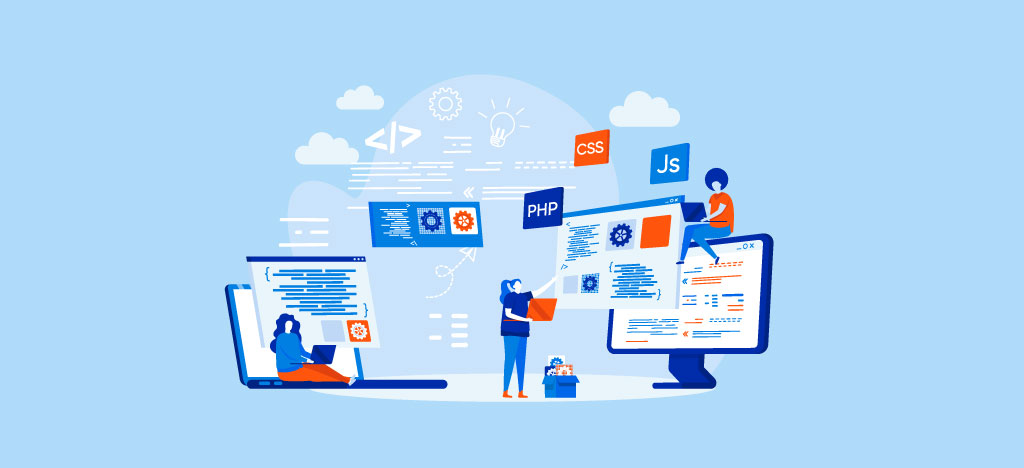The Ultimate Guide to Hiring Full Stack Developers in 2024

The digital age has elevated the importance of software development, with businesses becoming increasingly reliant on applications and websites to reach customers and streamline operations. Central to this process is the full stack developer, a professional skilled in handling both front-end and back-end tasks. They can oversee a full stack project from conception to completion, making them a valuable asset to any team.
An essential consideration for businesses is the cost of hiring a full stack developer. As we move into 2024, companies must understand these costs and how they are influenced by various factors such as geographic location, developer experience level, and project complexity. The affordability of these professionals can directly impact your business’s budget and overall success.
This guide’ll explore the details of hiring full stack developers. We will discuss both the factors affecting their cost and effective strategies for optimizing your hiring process.
Understanding Full Stack Development
A full stack developer is a versatile professional capable of handling the comprehensive development of software applications. These experts have the skills to work on an application’s front-end and back-end portions, making them integral to creating a seamless user experience and robust system architecture.
Front-End Development
Front-end development focuses on what users interact with directly. The role of a full stack developer extends beyond mere coding. It encompasses an understanding of the entire web development process from concept to deployment, ensuring each layer works harmoniously together. It involves designing and developing the layout, aesthetics, and interactive features of a website or application. Skills crucial to this domain include:
- Proficiency in HTML, CSS, and JavaScript.
- Familiarity with frameworks like React or Angular.
- Responsive design principles for various devices and screen sizes.
Back-End Development
Back-end development deals with server-side logic and integration. This includes database management, server configuration, and application logic. Essential skills include:
- Mastery of server-side programming languages such as Node.js, Ruby, or Python.
- Database management with tools like MySQL, MongoDB, or PostgreSQL.
- Knowledge of API creation and management.
Benefits of Hiring Full Stack Developers
When you hire a full stack developer in India, you can enjoy several benefits that can improve your company’s technology capabilities. Here are some advantages of hiring a full stack developer:
1. Versatility and Flexibility
Full stack developers have a wide range of skills, making them versatile and adaptable to different technologies and frameworks. This means they can easily switch between tasks and handle various project requirements without relying on other team members.
2. Comprehensive Skill Set
Full stack development services are proficient in both front-end and back-end development, allowing them to create complete web applications from start to finish. They have a deep understanding of the entire development process, including user interface design and server-side programming, which ensures a cohesive approach in building applications.
3. Streamlined Project Management
By working with a single developer who can handle all aspects of the development process, you can simplify communication and reduce the risk of misunderstandings between separate front-end and back-end teams. This streamlined communication often leads to faster project completion and more cohesive end products.
Hire fullstack developers into your team and enhance technical execution. It also optimizes project management and mobile app development. Their broad skill set can lead to more efficient development cycles and potentially lower costs by minimizing the need for multiple specialists.
Factors Affecting the Cost of Hiring a Full Stack Developer
When evaluating the cost of hiring a full stack developer, several factors come into play. These elements can significantly influence the overall cost and should be considered when planning your budget.
1. Geographic Locations
Geographic location significantly influences the average salary and freelance web developer hourly rate for full stack developers. Labor costs vary dramatically across different regions due to differences in living standards, economic conditions, and supply-demand dynamics in the workforce.
- In North America, full stack development agency earn an average of $81 to $100 per hour. However, rates can go up to a whopping $160 for highly experienced professionals.
- Developers from Asia might charge around $15 per hour due to lower living costs and an abundance of talent.
- Western Europe falls somewhere in between with rates ranging from €25-€80 per hour.
2. Project Complexity
The complexity and scope of your project can also impact the cost of hiring a full stack developer. Simple projects with clear-cut requirements may not require highly skilled or experienced developers and therefore may come at a lower cost.
However, more complex projects that involve intricate architectures, advanced functionalities, or innovative technologies may necessitate higher levels of expertise. Such proficiency often comes at a premium price.
3. Company Size
The size and nature of your company can influence the cost as well. Larger companies with more extensive projects may need to hire senior or lead developers who command higher salaries due to their expertise and experience.
On the other hand, startups or small businesses might find it more feasible to hire junior developers or freelancers who charge less but still possess the necessary skills for smaller-scale projects.
4. Hiring Model
The hiring model you choose can also impact the cost of the full stack developer hire process. In-house hiring often involves additional costs, such as benefits, taxes, and recruitment fees.
On the contrary, outsourcing or hiring freelancers can sometimes be a more cost-effective option. While freelance rates might be higher on an hourly basis, you save on overhead costs associated with full-time employees.
The hiring model you choose has significant cost implications when bringing a full stack developer on board. Here’s a look at how in-house and outsourcing options compare:
In-House Hiring
- Higher Initial Investment: In-house hiring often requires more upfront investment due to recruitment, interviewing, onboarding, and training costs.
- Long-Term Benefits: Although the initial cost is higher, in-house developers can lead to stronger team cohesion and company loyalty.
- Salary Considerations: In-house employees typically receive a full salary plus benefits, which geographic location average salary hourly rates can influence.
Outsourcing
- Lower Direct Costs: Outsourcing can reduce direct costs since it often excludes expenses like benefits, taxes, and office space.
- Flexibility: Offers flexibility in scaling the workforce up or down based on project requirements without the commitment of a full-time salary.
- Geographic Location Impact: Outsourcing to regions with lower average hourly rates can result in significant savings.
Understanding Hourly Rates for Full Stack Developers
When it comes to hiring a full stack developer, one significant factor affecting the cost is their hourly rate. An average web developer’s hourly rate is often determined by the developer’s experience and expertise. Notably, different experience levels command different hourly rates.
Hourly Rate Ranges Based on Experience Level
The experience level of a full stack developer plays a vital role in determining their hourly rate. You will come to know how much is full stack developer costs. Here’s an average breakdown:
- Senior Full Stack Developer
With years of experience under their belt, these developers bring extensive knowledge and skills to the table. They’re capable of handling complex projects and leading development teams effectively. As such, they command the highest rates, usually ranging between $75 to $100+ per hour.
- Mid-Level Full Stack Developer
These are developers who have gained some experience and improved their skills but are not yet at senior level. They can handle most tasks independently and contribute significantly to different stages of the project. Their hourly rates typically fall within the range of $50 to $75.
- Junior Full Stack Developer
As beginners in the field, these developers are still learning and growing. They can handle simpler tasks and need guidance from more experienced developers. However, they bring enthusiasm and fresh ideas to the team, making them valuable additions despite their lower experience level. The hourly rates for web developers usually range from $30 to $50.
Strategies for Reducing the Cost of Hiring Full Stack Developers
When looking to reduce the cost of hiring a full stack developer, one effective strategy is to explore alternative hiring options such as freelancers or part-time contractors. This approach offers several advantages that can significantly lower expenses while still ensuring access to the necessary skill sets.
Freelancers:
- Flexibility: Freelance full stack developers work on a project basis, allowing companies to hire them for specific tasks or assignments. This means you only pay for the work you need without the long-term financial commitment of a full-time salary.
- Diverse Expertise: A large pool of freelance developers can bring diverse skills and fresh perspectives to a project. They often have experience working on a variety of projects, which can add value to your development process.
- Reduced Overhead Costs: By working with full stack developer freelancers, businesses can save on costs associated with full-time employees such as office space, equipment, and employee benefits.
Part-Time Contractors:
- Scalability: Hiring part-time contractors allows for scalability. As your project needs change, you can easily adjust the software developer’s hourly rate and levels of expertise without the complexity of restructuring a full-time workforce.
- Cost Savings: Part-time contractors typically cost less than full-time employees when considering overall compensation packages, including health insurance, retirement benefits, and other perks that full-time employees expect.
- Specialized Skill Sets: Similar to freelancers, part-time contractors can be hired for their specialized skills that might only be needed for a phase of the project, optimizing your budget allocation for development tasks.
Estimating the Cost of Hiring a Full Stack Developer
Knowing the potential expense of hiring a dedicated developer is crucial for budget planning. This section will delve into key considerations that can influence the cost estimation for hiring a full stack developer:
- Experience Level: Junior developers will generally command lower rates, while senior or lead developers will charge at the higher end of the spectrum due to their extensive knowledge and skills.
- Geographic Location: The cost can vary significantly depending on whether you’re hiring locally or outsourcing overseas.
- Project Complexity: More complex projects may require more experienced (and thus, more expensive) developers.
- Hiring Model: In-house developers may have higher upfront costs (including benefits and taxes), while freelancers or outsourcing models might come with lower initial costs but potential additional expenses down the line.
Conclusion
Recognizing the crucial role that full stack developers play in both business growth and strategy implementation is crucial when entering the hiring process. The ability to navigate both front-end and back-end landscapes makes these professionals indispensable for companies looking to innovate and adapt in a constantly evolving digital marketplace.


